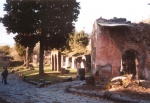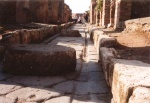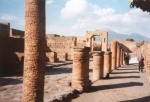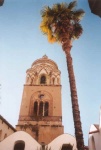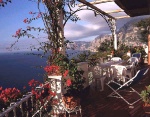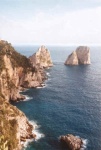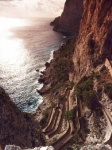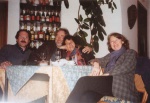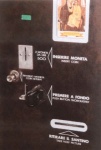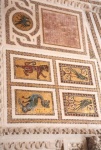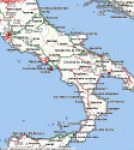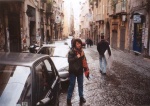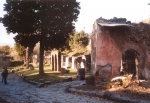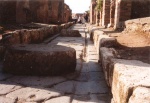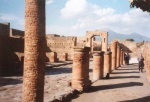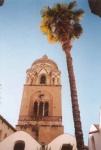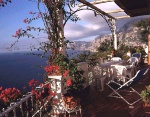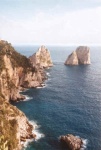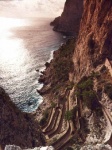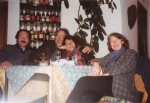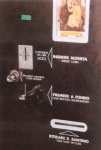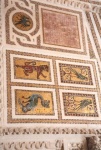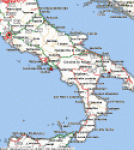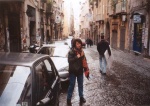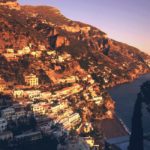 About eight years ago, in mid November, we were discussing what we would do for Thanksgiving. Both of our families live in San Francisco, and we would be visiting them in December. An ad in the Boston Globe caught our attention: $599 round trip for 6 nites in Rome, including air, hotel, transfers, and breakfasts. This was the start of what was to become an annual Thanksgiving tradition: while Americans traveled within the USA, we now head to Italy.
About eight years ago, in mid November, we were discussing what we would do for Thanksgiving. Both of our families live in San Francisco, and we would be visiting them in December. An ad in the Boston Globe caught our attention: $599 round trip for 6 nites in Rome, including air, hotel, transfers, and breakfasts. This was the start of what was to become an annual Thanksgiving tradition: while Americans traveled within the USA, we now head to Italy.
This year, we chose Italy’s Amalfi coast. This picturesque region, just south of Naples, is a short distance from Mt. Vesuvius and Pompeii. It also boasts some of the best pizza in the world. Our good friends, Tony and Erika, joined us for this trip. Traveling with them is wonderful and entertaining.
Torture by N-Star, our electric company: A few months ago, Susan committed the heinous crime of making a small change on N-Star’s website. N-Star, America’s least competent utility, decided what we really wanted was our electricity turned off. Susan physically stopped them from doing this a month ago – but a few hours before we were about to leave, they succeeded; and then the entire company went out to lunch. While Susan “shared her feelings” with those few unlucky souls who covered the phones, I went out to flag down an N-Star truck. We both succeeded simultaneously.
Atlanta shuts down
We had tickets on Sabena (at a great price), but they had the audacity to go belly-up a few weeks before we left (it could have been the day before). We got onto a combination of Delta and British Airways – which actually worked out better for us. But when we got to Logan, we found out that a security breach at Atlanta caused Delta (Atlanta-based) to flip out. The queues snaked thru the terminal, around the counters, and down the corridors. And we were at the end of the line. Although confident that they would not allow us to miss our flight, we were concerned that our plane or crew would.
At about this time, we realized that we had a guardian angel following us. When we travel, everything usually goes quite smoothly. Now, just about everything was going wrong, but magically resolving itself. When we landed in London, we found that Delta said we never took our flight, and thus cancelled the rest of our itinerary. But that too resolved itself, when the ticket agent realized that we were standing in front of her and weren’t figments of her imagination, and therefore HAD taken the flight to London! I guess that getting there is half the fun.
The flight to Naples was painless, and we’d easily found Tony and Erika in the London airport. In spite of some language difficulties, our rental car was waiting for us in Naples, and we set out to test ourselves against the Italian drivers during the two-hour drive to our accommodations in Positano. After a short drive we reached the coast, and began navigating the winding roads, with a different vista around each bend.
The Amalfi Coast is said to be the most spectacular in Europe. The winding road precariously hugs the cliff face, often 1000 feet over the Mediterranean. Every turn offers breathtaking panoramic views. The houses, all nestled into the mountains, are all painted in whites and pastels. Each village is a series not of streets — but staircases. Compact gardens surround each house, often with palms, bougainvillea, gardenias, morning glory, and other flowers and vegetables. Ruined and preserved medieval castles, watchtowers, and convents dot the landscape. Vineyards and citrus groves cover the stepped hillsides. The domes and towers of Moorish-design cathedrals dominate the skyline of each small village. There are no McDonalds, Starbucks, or Wal-Marts, no tourist traps, cheesy wax museums, nor endless stands of tourist dreck.
We’d rented a 2-bedroom apartment, Villa Amore on the Positano/Praiano line. It was fairly easy to find. We were initially daunted by the 120 steps to the front door, but the climb was worth it. It was one of the nicest places we’ve ever stayed. The front of the house had a bougainvillea-lined balcony with vistas of the sea and fabulous coastline, and each bedroom, the living room, and the eat-in kitchen had doors opening onto this wonderful view. Tearing ourselves away was a challenge each morning – and those stairs kept us from overindulging in good Italian wines each night!
An hour off the tip of the peninsula is Capri, a sleepy island consisting of medieval winding streets, brightly painted fishing boats, steep cliffs, blue seas, and beautiful gardens. The main city is blessed by having no cars, just walkways and stairs – and endless designer boutiques. We walked to Augustus Gardens, built on the ruins of an ancient Roman villa. The views are extraordinary. There’s a 100-foot sheer drop into the sea, rugged rocks protruding from the water, and small houses perched at every nook in the stone.
Pompeii was buried in 79 CE (AD), when Mount Vesuvius erupted. The ashes, gases, and molten rock claimed many lives, though also served to preserve the debris, offering a view of the typical Roman city at the height of the Empire. Found in the ashes were people and everyday items, food and domestic animals, all hidden until the first half of the eighteenth century, when regular digs were organized.
Documentaries cannot do Pompeii justice. The sheer size and opulence of the city is overwhelming. Knowing that it was repeatedly plundered over the past 250 years only enhances one’s sense of awe. Unfortunately, erosion has done more damage than 2000 years of being buried. The delicate frescoes are faded; there are few remaining mosaics. Instead, many of the artifacts have been moved to the museum in Naples.
Pompeii was the truly one of the highlights of our trip. Its miles of ruins with fragments of columns, gardens, sculpture, mosaics and wall paintings that gave a glimpse of the grandeur of the society that was buried by Vesuvius.
Also buried by the Mt. Vesuvius eruption that destroyed Pompeii, Herculaneum is in the heart of a suburb of Naples amidst traffic and urban sprawl. As it’s allegedly a minor site, it was hard to find, as street signs directing us there were all but absent. Its entrance is also unassuming – we almost drove right by it. A TV special on the opulence of Herculaneum drew us to this area – and we were not disappointed.
Since excavation on Herculaneum started in 1927, it was not subject to the same looting as Pompeii. It was also in somewhat better shape, with much of the wood in the buildings still present. They’ve only excavated a relatively small area, 8 square blocks. Wealthier than Pompeii, it’s houses are more sumptuous, often with finer frescoes, mosaics, and statuary, and their gardens and foundations have been accurately outlined and some of the architecture has been restored.
The overt sexuality, exemplified by the presence of brothels and murals, gave us a glimpse into one aspect of daily life, and reminded us that some things haven’t changed through the centuries. But most impressive were the paintings. The style was almost identical to Italian renaissance art, implying that style was never forgotten, just driven underground.
Located about 2 hours south of Positano is Paestum, a Greek colony in amazingly good condition. It holds the largest and best-preserved Greek ruins and temples outside of the Acropolis. Paestum is noted for it’s finely painted tombs, included the “Tomb of the Diver”. The extensive bilingual museum contains an astounding collection of artifacts, tombs, mosaics, and background information. The only drawback to visiting Paestum is that’s in the middle of nowhere. We passed by endless miles of many dozens of nightclubs.
Although Naples is widely perceived as a crime-ridden slum, it has a lot to offer. While we were only able to see the museum and a tiny corner of a shopping area, the city was vibrant and colorful. The traffic and noise was like any other city, and at no time did we fell unsafe. The National Archeology Museum was overwhelming.
(Just a hint – there’s one room that contains “erotic” art for which you’ll need a timed free pass. It’s worth seeking out this pass, as the collection is extremely interesting). We stayed in the Hotel Prati www.hotelprati.it for about $100 per night. This 3-star hotel is conveniently located near the train station, but a bit faded. If luxury is important, than the hotels in the western (new) part of Naples are supposed to be nicer. But the location was great and the staff could not have been nicer.
The sights, sounds, and smells of Italy: Every trip to Italy is a sensory experience. The food is exquisite, the sights are fantastic, and the smells – pizza, garlic, basil, ahhhh… We had great meals, we had exceptional meals, and we even had one bad meal (at a NYTimes recommended restaurant, see at the end). But the one thing that amazed us was the reasonable prices of the restaurants. A good Italian meal in Boston would cost $60+ for two. We were spending half that amount in Italy. In late November, Novellos (“new” wines) become available. We’ve become quite fond of these young wines and urge travelers to try them when they’re available.
Lodging: We rented a 2-bedroom apartment, Villa Amore on the Positano/Praiano line. Although it was up 120-odd steps, it was one of the nicest places we’ve ever stayed. It was roomy homey, reasonably priced, and the owner, Mrs. Anna was delightfully friendly and helpful. We paid $675 for the week rented thru her agent at www.villeinitalia.com. The agent Ville in Italia was perfect in every respect.
Driving: As usual, we rented a roomy diesel Opel station wagon thru Kemwel (www.kemwel.com). Kemwel only rents with the CDW insurance, but even with it, it was less expensive than the regular companies. The car was actually provided by National/Maggiore.
The rugged coastline was spectacular (photo by Tony)The narrow roads are roomy for one small car, comfortable for two small cars, but add buses, motor scooters, and the Italian penchant for parking wherever they damn well please, driving was challenging — and I’m a Bostonian. I was warned that the drivers would all be suicidal madmen. In reality, some were pretty gutsy, but most were very courteous. Of course, I drive like they do. I pity midwesterners. Erika and I split the driving, so both of us had a chance to admire the extraordinary scenery.
Recommendations
Shopping: Ceramics are available throughout the area, but the center of plates and small ceramics is Vietri sul Mare. A group of shops near the main road has an extraordinary selection and very reasonable prices. Also, about 2 miles west of the Positano/Praiano line is Ceramica Casola www.ceramicacasola.com, which specializes in tabletops. We’re having a custom ceramic tabletop made there.
Restaurant to visit: The Taverna di Leone. Recommended by our landlady, the Scialatelli della Casa was superb. Also try the Misto di Verdura de la Casa, but be sure to split it among 2 people. The portions are hearty, the quality is exceptional, and the staff went out of their way to make us feel welcome – as they did for all their clients. It’s on the north side of the road about a mile west of the Praiano/Positano line.
Restaurant to avoid: The “53” in Naples. This appeared in our guidebook as well as the NY Times. They forgot one of our 4 entrees, the other 3 were mediocre at best. The staff did not offer us the daily specials, but did offer them to the other diners. They overcharged for one of the items. The waiter offered only a shrug when asked about the forgotten meal. Note that there was no language barrier, as one of our troupe spoke Italian. Whether they treated us poorly because we were tourists or because their service and quality had deteriorated is irrelevant. With all the exceptional restaurants in Naples, going there is a waste of time and money.
Guidebook: We used the Knopf Naples/Pompeii guide and Erika had the Eyewitness Naples/Pompeii guide. The two made a good combination, but individually each would have been inadequate.

